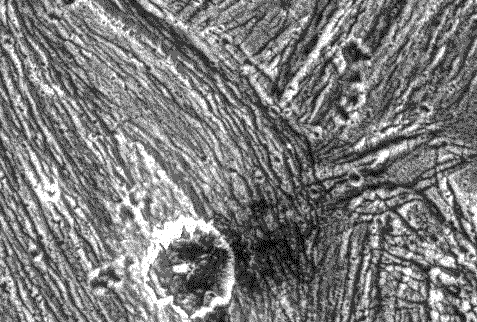Astronomy Picture of the Day
Discover the cosmos!
Each day a different image or photograph of our fascinating universe is
featured, along with a brief explanation written by a professional
astronomer.
July 11, 1996

Ganymede: A Really Groovy Moon
Credit:
Galileo Mission
Team,
Galileo Spacecraft,
NASA
Explanation:
Ganymede's surface is a wrinkled mess. As large ice-sheets shift on
the
moon's surface, parts of the surface buckle causing high ridges, deep
furrows, and parallel grooves.
This photo,
taken by the
Galileo
spacecraft
currently orbiting
Jupiter, was
released yesterday.
The large circular feature near the picture bottom is a large impact
crater. The impact that caused this large crater also caused the strange
dark ejecta seen to the crater's right. The Sun illuminates the scene from
the lower left. The
Galileo spacecraft
has also just discovered that
Ganymede
has a region of orbiting charged particles called a magnetosphere -
a first for any moon. How
Ganymede
is able to generate a
magnetosphere
is a mystery.
APOD's Archive of Galileo at Ganymede
Tomorrow's picture: Ancient Cratered Plains on Ganymede
<
Archive
| Index
| Search
| Calendar
| Glossary
| Education
| About APOD
>
Authors & editors:
Robert Nemiroff
(MTU) &
Jerry
Bonnell (USRA)
NASA Technical Rep.:
Jay Norris.
Specific rights apply.
A service of:
LHEA
at
NASA/
GSFC
&:
Michigan Tech. U.
